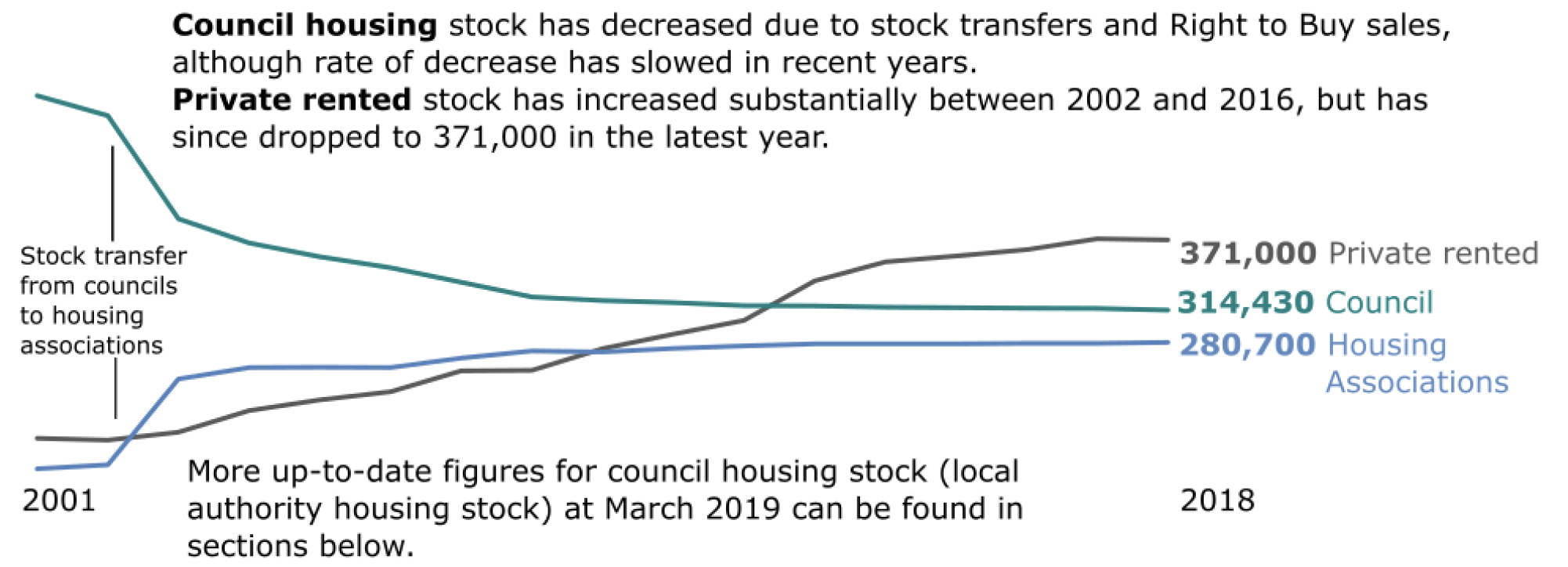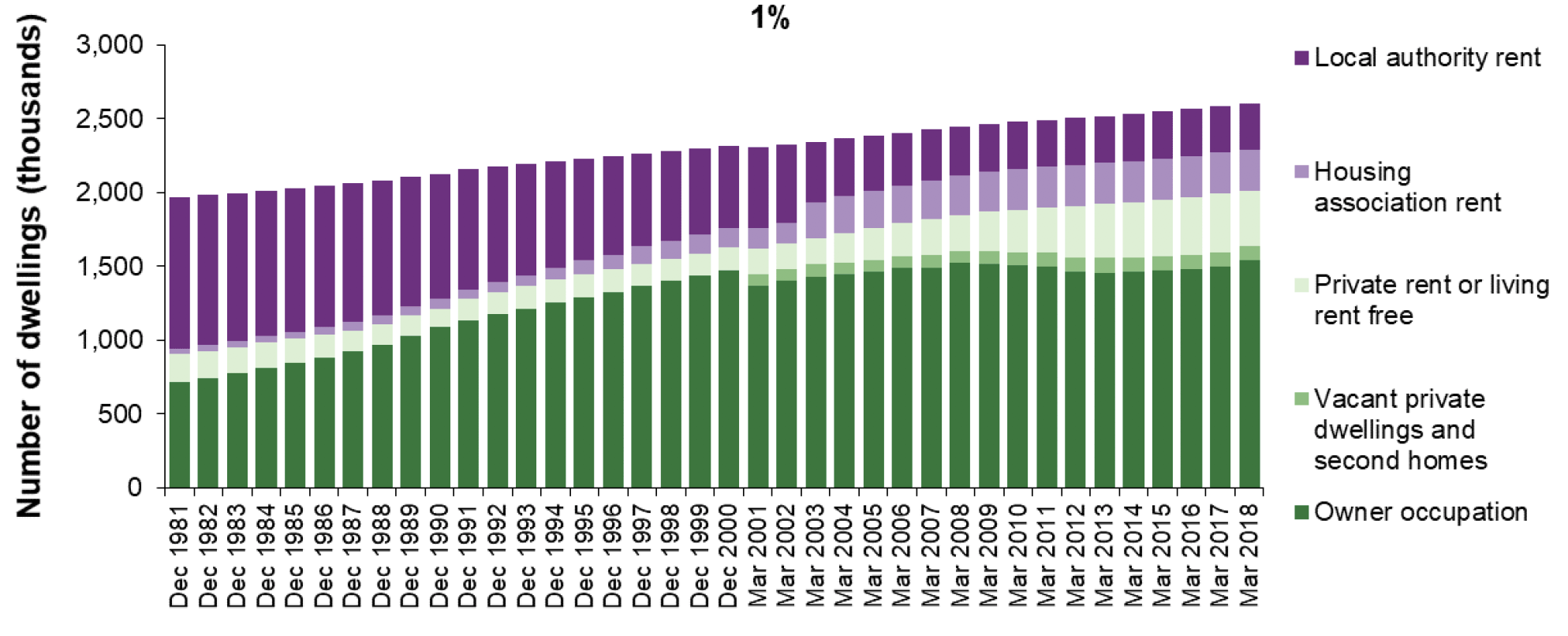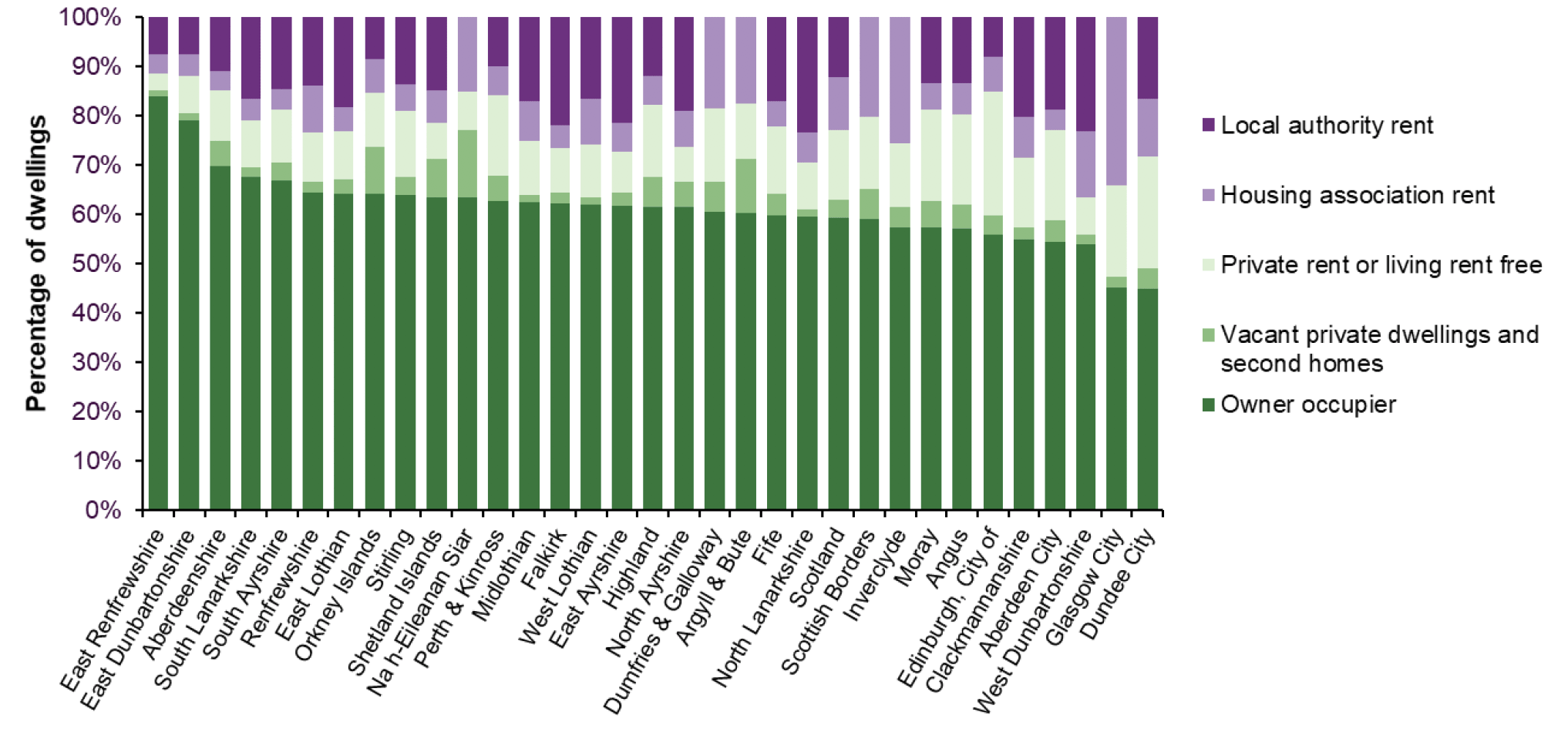Housing statistics 2019: key trends summary
Annual statistics up to 31 March 2018 on total new housing supply in Scotland across all sectors, along with information on various elements of local authority housing such as stock, lettings, house sales, evictions, housing lists, and housing for older people and people with disabilities.
This document is part of a collection
Stock by Tenure to end March 2018
As at 31st March 2018, there were an estimated 2.6 million dwellings in Scotland, an increase of 1% (20,000 dwellings) compared to 2017. The number of owner occupier households increased by an estimated 3%, and the number of housing association homes increased by 1%, whilst the number of local authority homes showed little change year on year (0%), and the number of dwellings rented privately (including with a job/business or rent-free) decreased by an estimated 6%.
Note within this section that figures presented on the number of privately rented and owner occupied dwellings should be treated as approximate estimates given that these are based on survey data from the Scottish Household Survey, from which there will be a margin of error associated with the results. This differs from the figures presented on the number of social rented dwellings, which are based on administrative counts of units of stock held by local authorities and housing associations, and therefore are likely to be more accurate counts of the exact numbers of dwellings.
The number of dwellings in Scotland has increased by 635,000 in the last 3 decades from 1.97 million in 1981 to 2.61 million in 2018. This has coincided with an increasing Scottish population and the increased prevalence of smaller households[2].
Chart 6a shows trends in rented stock between 2001 and 2018, in which it can be seen that council housing stock has decreased, due to stock transfers and Right to Buy sales, although the rate of decrease has slowed in recent years. Private rented stock increased substantially between 2002 and 2016, but has since dropped slightly in the latest year.
Chart 6a: Private rented stock increased substantially between 2002 and 2016, but has since dropped to 370,500 in the latest year

Chart 6b presents trends from 2001 across all tenure types, including owner occupation. It can be seen that the reduction in owner occupation between 2008 and 2014 has coincided with an increase in the number of households renting privately or living rent free from 10% (around 248,000 dwellings) in 2008 to 15% (around 382,000 dwellings) in 2015, as shown in Chart 6b. This may have been partly caused by the economic downturn and the difficulty potential home owners have subsequently experienced in securing a mortgage. Although in the latest year the number of households renting privately or living rent free has droped to around 371,000, a decrease of around 6% from 2016 to 2018, with the number of owner occupier households increasing by approximately 3%.
Chart 6b: Total Dwellings increased by 1% in 2018-19, including an increase in owner occupation properties of 3% and Housing Asociation rented properties of 1%

Note the change in methodology from March 2001. Scottish Household Survey data combined with dwelling counts of occupied and vacant property (National Records of Scotland data) to split privately owned stock into owner occupied, private rented and vacant. Social rented stock counts provided by local authorities and the Scottish Housing Regulator.
Local authority level tenure estimates are shown in Chart 7. The rate of owner occupation varies from 84% in East Renfrewshire to 45% in Dundee City. In general, cities have lower owner occupation rates. The proportion of dwellings rented privately ranges from 3% in East Renfrewshire to 25% in Edinburgh, with cities tending to have higher rates of households in the private rented sector. Percentages of households that are social renting range from 11% in East Renfrewshire to 34% in Glasgow and 37% in West Dunbartonshire.
Chart 7:Tenure estimates by local authority area show that the rate of owner occupation rates varies from 84% in East Renfrewshire to 45% in Dundee City

Link to tenure tables: http://www.scotland.gov.uk/Topics/Statistics/Browse/Housing-Regeneration/HSfS/KeyInfo
The Scottish Household Survey website presents information on housing stock by tenure. Chapter 3 on Housing contains tables on tenure of household by year and by household age group: http://www.gov.scot/Topics/Statistics/16002/PublicationAnnual
Statistics on housing stock by tenure in the other UK nations can be found through the following link to the Ministry of Housing, Communities and Local Government website: http://www.communities.gov.uk/housing/housingresearch/housingstatistics/housingstatisticsby/stockincludingvacants/livetables/
ONS produce subnational dwelling stock by tenure estimates for England at https://www.ons.gov.uk/peoplepopulationandcommunity/housing/datasets/subnationaldwellingstockbytenureestimates
Scottish Government Social Tenants Statistics compendium publications present information on stock by tenure by country, for both social rented sector stock as well as for other tenures:
https://www.gov.scot/publications/social-tenants-scotland-2017/
Contact
Email: lyndsey.middleton@gov.scot
There is a problem
Thanks for your feedback